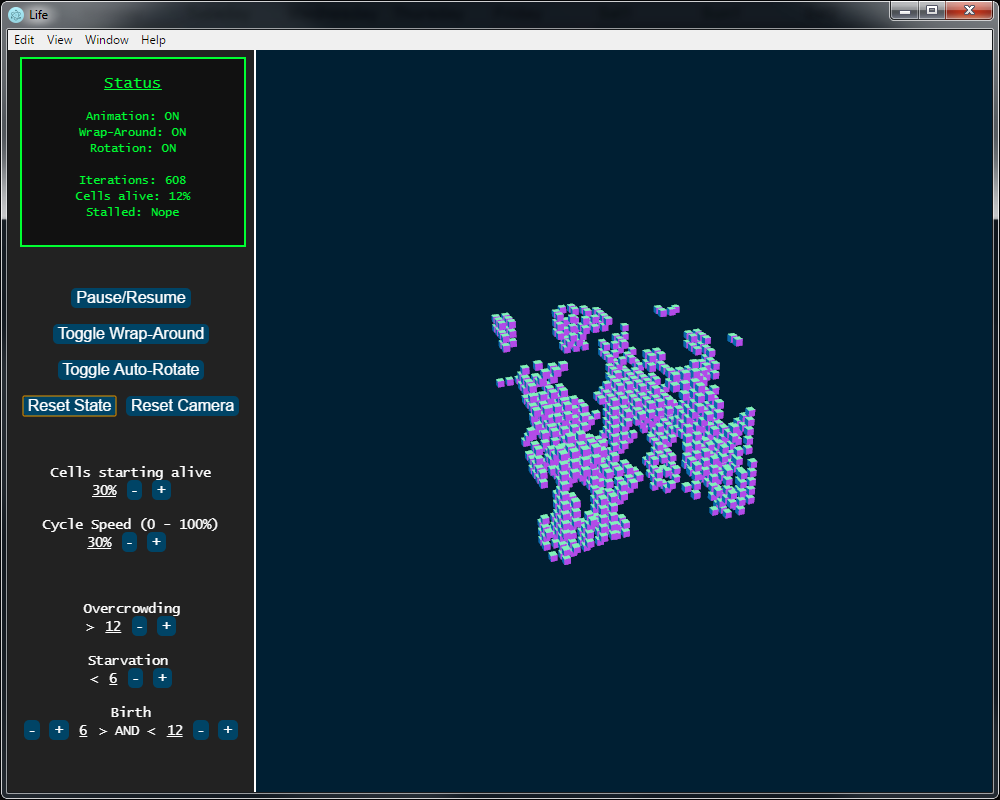See below for details of original version - "Conway's Game of Life".
Implementing the game of life in 3 dimensions requires adjusting the rules to account for the increase in neighbors. It's hard to find what specific values could lead to a cellular automata comparable to that in the 2D version of the game, so I initialize the program with values proportional to the 2D values.
This implementation is written in JavaScript, with features from ES5 and ES6, using the Three.js graphics library and is available as a desktop application thanks to the Electron.js library.
Running the program as a desktop application rather than a webpage allows for much better performance.
- Install Electron.js -
npm install -g electron - Clone this repository.
- Choose to run the app as a desktop or web application
- To run as a desktop application
- From inside your cloned directory, run
electron .
- From inside your cloned directory, run
- To run as a webpage
- Open the
index.htmlfile with Google Chrome or Mozilla Firefox
- Open the
- Available as a desktop application on any OS
- Available as a web application
- Fast 3D graphics with Three.js
- Camera is controllable with mouse
- Simple, easy to use interface
- Auto-rotation to show entire scene
- Status menu shows number of iterations and percentage of cells alive
- Reset and restart the game with the click of a button
- Adjustable
- While running the program these variables are adjustable in real-time:
- Percentage of cells to initialize in the alive state
- 'Wrap-around' on or off; allows for infinite-size world simulation
- 'Auto-rotate' on or off
- Speed at which the world iterates to the next state
- All of the rules of the game: overcrowding, starvation, and the birth-range
- While running the program these variables are adjustable in real-time:
- Customizable - safe-to-change variables in
app.jsundersettings- Size of and spacing between cells
- Number of cells along each row/column/layer
- Speed of auto-rotation
From the Conway's Game of Life Wikipedia entry.
The Game of Life, also known simply as Life, is a cellular automaton devised by the British mathematician John Horton Conway in 1970.[1]
The "game" is a zero-player game, meaning that its evolution is determined by its initial state, requiring no further input. One interacts with the Game of Life by creating an initial configuration and observing how it evolves, or, for advanced "players", by creating patterns with particular properties.
The universe of the Game of Life is an infinite two-dimensional orthogonal grid of square cells, each of which is in one of two possible states, alive or dead, or "populated" or "unpopulated" (the difference may seem minor, except when viewing it as an early model of human/urban behavior simulation or how one views a blank space on a grid). Every cell interacts with its eight neighbours, which are the cells that are horizontally, vertically, or diagonally adjacent. At each step in time, the following transitions occur:
- Any live cell with fewer than two live neighbours dies, as if caused by under-population.
- Any live cell with two or three live neighbours lives on to the next generation.
- Any live cell with more than three live neighbours dies, as if by over-population.
- Any dead cell with exactly three live neighbours becomes a live cell, as if by reproduction.
The initial pattern constitutes the seed of the system. The first generation is created by applying the above rules simultaneously to every cell in the seed—births and deaths occur simultaneously, and the discrete moment at which this happens is sometimes called a tick (in other words, each generation is a pure function of the preceding one). The rules continue to be applied repeatedly to create further generations.
The MIT License
Copyright (c) 2014 GitHub Inc. (Electron.js) Copyright © 2010-2015 three.js authors (Three.js)
Permission is hereby granted, free of charge, to any person obtaining a copy of this software and associated documentation files (the "Software"), to deal in the Software without restriction, including without limitation the rights to use, copy, modify, merge, publish, distribute, sublicense, and/or sell copies of the Software, and to permit persons to whom the Software is furnished to do so, subject to the following conditions:
The above copyright notice and this permission notice shall be included in all copies or substantial portions of the Software.
THE SOFTWARE IS PROVIDED "AS IS", WITHOUT WARRANTY OF ANY KIND, EXPRESS OR IMPLIED, INCLUDING BUT NOT LIMITED TO THE WARRANTIES OF MERCHANTABILITY, FITNESS FOR A PARTICULAR PURPOSE AND NONINFRINGEMENT. IN NO EVENT SHALL THE AUTHORS OR COPYRIGHT HOLDERS BE LIABLE FOR ANY CLAIM, DAMAGES OR OTHER LIABILITY, WHETHER IN AN ACTION OF CONTRACT, TORT OR OTHERWISE, ARISING FROM, OUT OF OR IN CONNECTION WITH THE SOFTWARE OR THE USE OR OTHER DEALINGS IN THE SOFTWARE.

